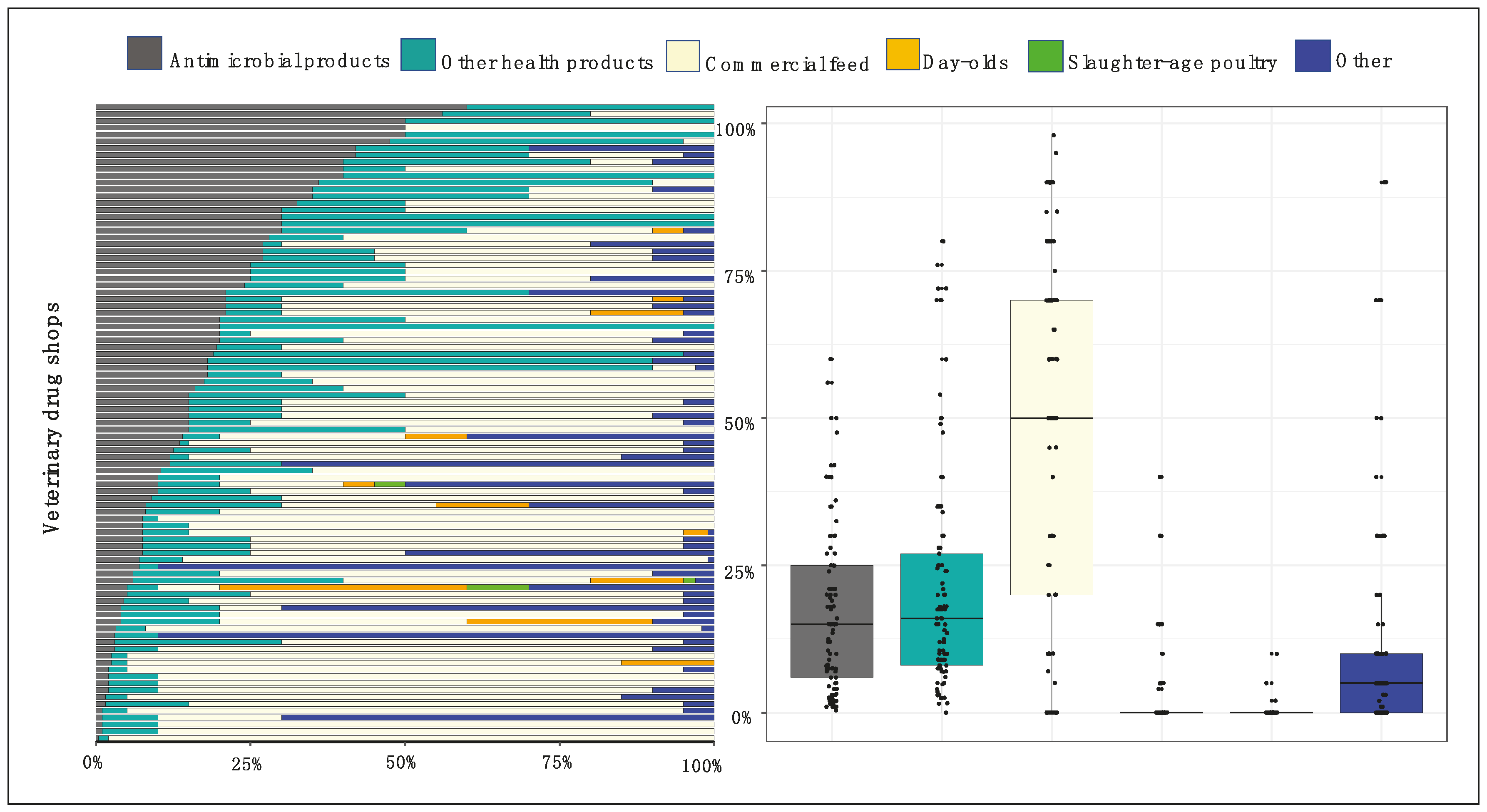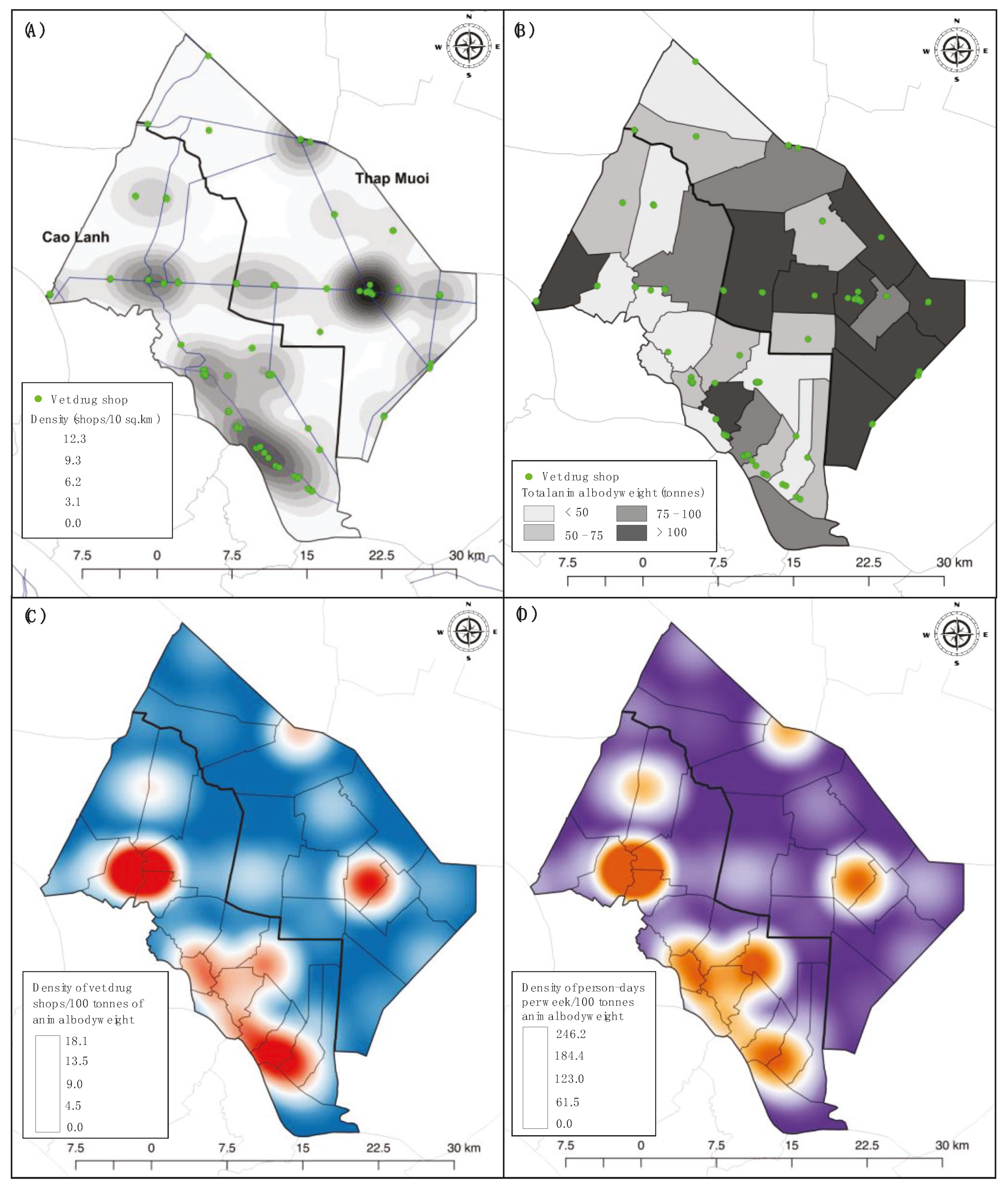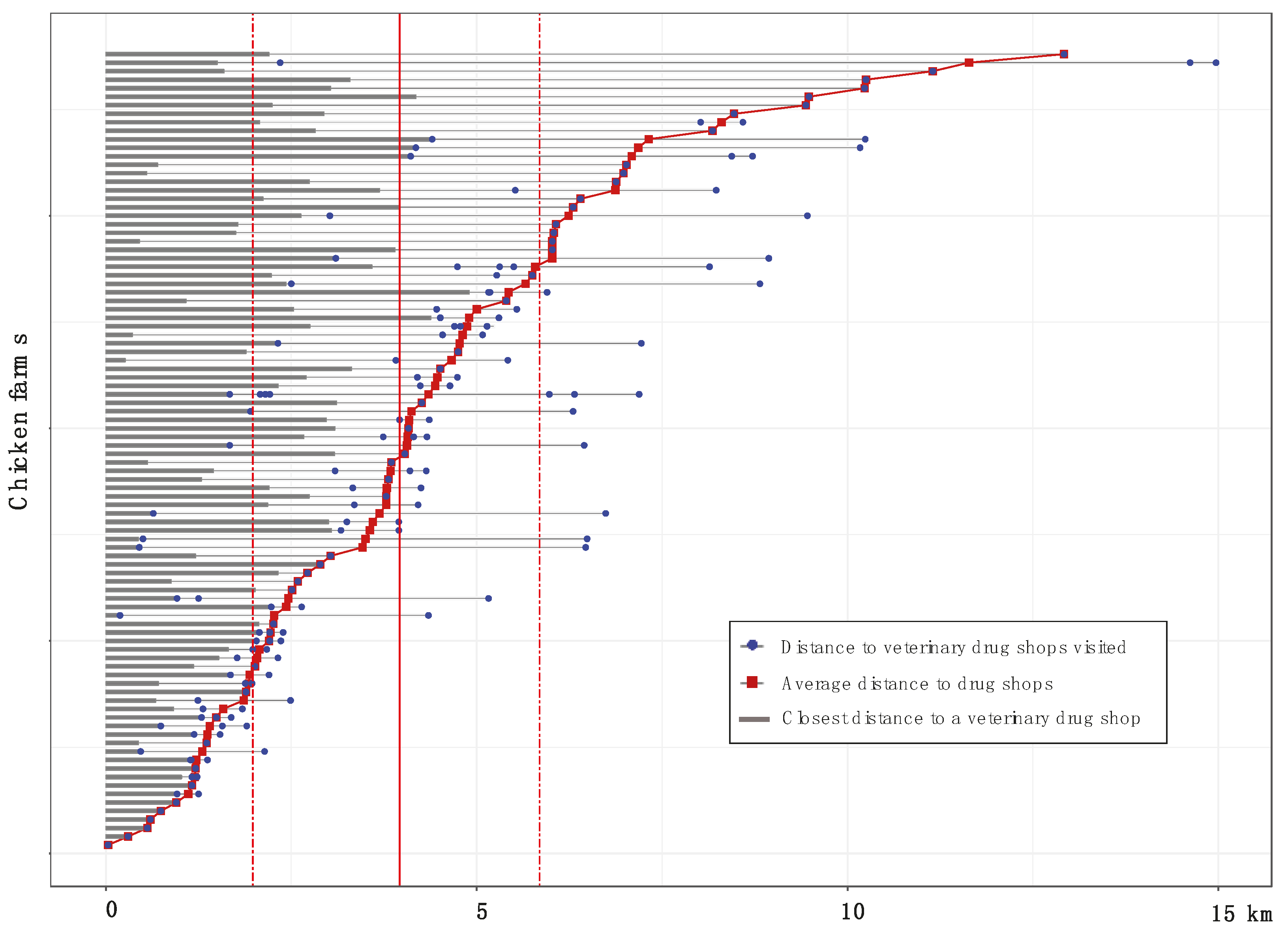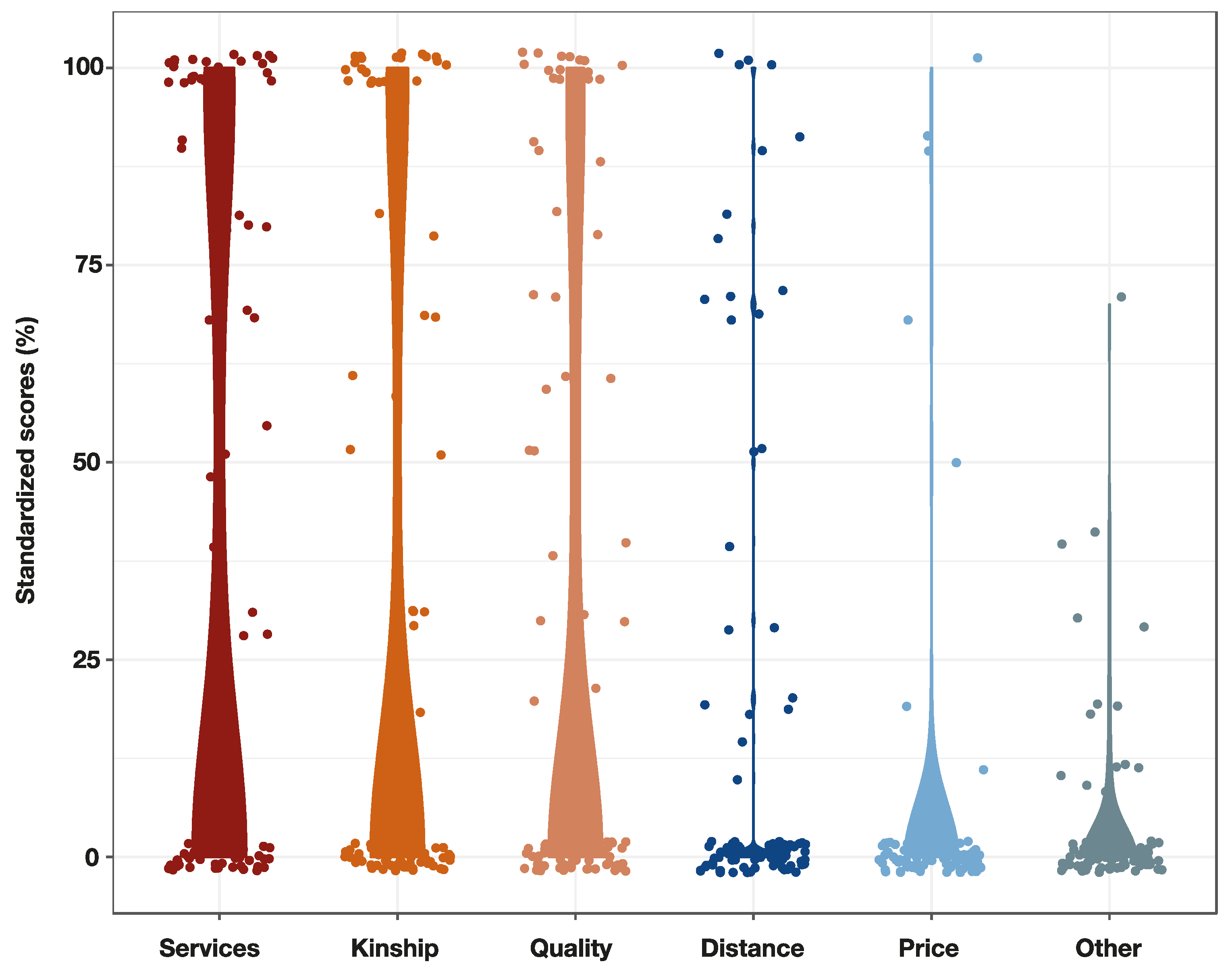Veterinary Drug Shops as Main Sources of Supply and Advice on Antimicrobials for Animal Use in the Mekong Delta of Vietnam
Abstract
1. Introduction
2. Results
2.1. Characteristics of Veterinary Drug Shops
2.2. Mapping of Veterinary Drug Shops and Livestock Populations
2.3. Correlation between Number of Veterinary Drug Shops and Livestock Population
2.4. Linkages between Veterinary Drug Shops and Chicken Farms
2.5. Risk Factor Analyses
3. Discussion
4. Materials and Methods
4.1. Study Area, Populations and Veterinary Drug Shops
4.2. Correlation between Veterinary Drug Shop and Livestock Population
4.3. Mapping of Veterinary Drug Shops and Livestock Density
4.4. Survey of Veterinary Drug Shops and Chicken Farmers
4.5. Risk Factor Analysis
5. Conclusions
Supplementary Materials
Author Contributions
Funding
Acknowledgments
Conflicts of Interest
References
- Ayukekbong, J.A.; Ntemgwa, M.; Atabe, A.N. The threat of antimicrobial resistance in developing countries: Causes and control strategies. Antimicrob. Resist. Infect. Control 2017, 6, 47. [Google Scholar] [CrossRef] [PubMed]
- Zellweger, R.M.; Carrique-Mas, J.; Limmathurotsakul, D.; Day, N.P.J.; Thwaites, G.E.; Baker, S.; on behalf of the Southeast Asia Antimicrobial Resistance Network; Members of the Southeast Asia Antimicrobial Resistance Network; Ashley, E.; de Balogh, K.; et al. A current perspective on antimicrobial resistance in Southeast Asia. J. Antimicrob. Chemother. 2017, 72, 2963–2972. [Google Scholar] [CrossRef] [PubMed]
- WHO Stop Using Antibiotics in Healthy Animals to Prevent the Spread of Antibiotic Resistance. Available online: https://www.who.int/news-room/detail/07-11-2017-stop-using-antibiotics-in-healthy-animals-to-prevent-the-spread-of-antibiotic-resistance (accessed on 21 May 2019).
- ECDC/EFSA/EMA First Joint Report on the Integrated Analysis of the Consumption of Antimicrobial Agents and Occurrence of Antimicrobial Resistance in Bacteria from Humans and Food-Producing Animals; Joint Interagency Antimicrobial Consumption and Resistance Analysis (JIACRA) Report; p. 114. Available online: https://efsa.onlinelibrary.wiley.com/doi/10.2903/j.efsa.2015.4006 (accessed on 3 July 2019).
- Roess, A.; Leibler, J.H.; Graham, J.P.; Lowenstein, C.; Waters, W.F. Animal Husbandry Practices and Perceptions of Zoonotic Infectious Disease Risks Among Livestock Keepers in a Rural Parish of Quito, Ecuador. Am. J. Trop. Med. Hyg. 2016, 95, 1450–1458. [Google Scholar]
- Van Boeckel, T.P.; Brower, C.; Gilbert, M.; Grenfell, B.T.; Levin, S.A.; Robinson, T.P.; Teillant, A.; Laxminarayan, R. Global trends in antimicrobial use in food animals. Proc. Natl. Acad. Sci. USA 2015, 112, 5649–5654. [Google Scholar] [CrossRef] [PubMed]
- Carrique-Mas, J.J.; Trung, N.V.; Hoa, N.T.; Mai, H.H.; Thanh, T.H.; Campbell, J.I.; Wagenaar, J.A.; Hardon, A.; Hieu, T.Q.; Schultsz, C. Antimicrobial Usage in Chicken Production in the Mekong Delta of Vietnam. Zoonoses Public Health 2015, 62, 70–78. [Google Scholar] [CrossRef] [PubMed]
- Carrique-Mas, J.; Van, N.T.B.; Cuong, N.V.; Truong, B.D.; Kiet, B.T.; Thanh, P.T.H.; Lon, N.N.; Giao, V.T.Q.; Hien, V.B.; Padungtod, P.; et al. Mortality, disease and associated antimicrobial use in commercial small-scale chicken flocks in the Mekong Delta of Vietnam. Prev. Vet. Med. 2019, 165, 15–22. [Google Scholar] [CrossRef] [PubMed]
- Ngo, T.T. Veterinary Medicine Trading according to Veterinary Law in 2015. Master of Law, Vietnam Academy of Social Science: Ha Noi. 2015. Available online: http://vannghiep.vn/wp-content/uploads/2018/04/Kinh-doanh-thuốc-thú-y-theo-Luật-Thú-y-năm-2015-.pdf (accessed on 13 May 2019). (In Vietnamese).
- Summary of the Viet Nam Action Plan for AMU/AMR Reduction in Livestock Sector|FAO in Viet Nam|Food and Agriculture Organization of the United Nations. Available online: http://www.fao.org/vietnam/news/detail-events/en/c/451446/ (accessed on 20 October 2019).
- The FAO Action Plan on Antimicrobial Resistance 2016–2020|Global Forum on Food Security and Nutrition (FSN Forum). Available online: http://www.fao.org/fsnforum/resources/fsn-resources/fao-action-plan-antimicrobial-resistance-2016-2020 (accessed on 20 October 2019).
- Carrique-Mas, J.; Van Cuong, N.; Truong, B.D.; Phu, D.H.; Phuc, T.M.; Turner, H.; Thwaites, G.; Baker, S. Affordability of antimicrobials for animals and humans in Vietnam: A call to revise pricing policies. Int. J. Antimicrob. Agents 2019, 54, 269–270. [Google Scholar] [CrossRef] [PubMed]
- Cuong, N.; Padungtod, P.; Thwaites, G.; Carrique-Mas, J. Antimicrobial Usage in Animal Production: A Review of the Literature with a Focus on Low- and Middle-Income Countries. Antibiotics 2018, 7, 75. [Google Scholar] [CrossRef] [PubMed]
- Nhung, N.; Cuong, N.; Thwaites, G.; Carrique-Mas, J. Antimicrobial Usage and Antimicrobial Resistance in Animal Production in Southeast Asia: A Review. Antibiotics 2016, 5, 37. [Google Scholar] [CrossRef]
- Cuong, N.V.; Phu, D.H.; Van, N.T.B.; Dinh Truong, B.; Kiet, B.T.; Hien, B.V.; Thu, H.T.V.; Choisy, M.; Padungtod, P.; Thwaites, G.; et al. High-Resolution Monitoring of Antimicrobial Consumption in Vietnamese Small-Scale Chicken Farms Highlights Discrepancies Between Study Metrics. Front. Vet. Sci. 2019, 6, 174. [Google Scholar] [CrossRef] [PubMed]
- Truong, D.B.; Doan, H.P.; Doan Tran, V.K.; Nguyen, V.C.; Bach, T.K.; Rueanghiran, C.; Binot, A.; Goutard, F.L.; Thwaites, G.; Carrique-Mas, J.; et al. Assessment of Drivers of Antimicrobial Usage in Poultry Farms in the Mekong Delta of Vietnam: A Combined Participatory Epidemiology and Q-Sorting Approach. Front. Vet. Sci. 2019, 6, 84. [Google Scholar] [CrossRef]
- Erickson, A.K. Hospital pharmacists are essential to antimicrobial stewardship. Pharm. Today 2016, 22, 6–7. [Google Scholar] [CrossRef]
- ASHP Statement on the Pharmacist’s Role in Antimicrobial Stewardship and Infection Prevention and Control. Am. J. Health. Syst. Pharm. 2010, 67, 575–577. [CrossRef] [PubMed]
- Kotwani, A.; Wattal, C.; Katewa, S.; Joshi, P.C.; Holloway, K. Factors influencing primary care physicians to prescribe antibiotics in Delhi India. Fam. Pract. 2010, 27, 684–690. [Google Scholar] [CrossRef] [PubMed]
- Biedron, C.; Chopra, T. Issues Surrounding Antibiotic Use in Older Adults. Curr. Transl. Geriatr. Exp. Gerontol. Rep. 2013, 2, 151–158. [Google Scholar] [CrossRef]
- Thi Quynh Nhi, L.; de Alwis, R.; Khanh Lam, P.; Nhon Hoa, N.; Minh Nhan, N.; Thi Tu Oanh, L.; Thanh Nam, D.; Nguyen Ngoc Han, B.; Thi Thuy Huyen, H.; Thi Tuyen, D.; et al. Quantifying antimicrobial access and usage for paediatric diarrhoeal disease in an urban community setting in Asia. J. Antimicrob. Chemother. 2018, 73, 2546–2554. [Google Scholar] [CrossRef] [PubMed]
- Teufel, N.; Markemann, A.; Kaufmann, B.; Zárate, A.V.; Otte, J. Livestock Production Systems. p. 111. Available online: http://www.fao.org/3/a-bp184e.pdf (accessed on 31 July 2019).
- QGIS Heatmap Using Kernel Density Estimation Explained. Available online: https://www.geodose.com/2017/11/qgis-heatmap-using-kernel-density.html (accessed on 21 January 2019).
- Carrique-Mas, J.J.; Rushton, J. Integrated Interventions to Tackle Antimicrobial Usage in Animal Production Systems: The ViParc Project in Vietnam. Front. Microbiol. 2017, 8, 1062. [Google Scholar] [CrossRef] [PubMed]




| Characteristics | All (n = 93) | <15% Antimicrobial Sales (n = 45) | ≥15% Antimicrobial Sales (n = 48) |
|---|---|---|---|
| Owner’s gender (%) | |||
| Male | 62 (66.7%) | 31 | 31 |
| Female | 31 (33.3%) | 14 | 17 |
| Owner’s age in year (median [IQR]) | 40 [36–51] | 39 [36–48] | 44 [38–52] |
| Education status (%) | |||
| Master’s degree | 1 (1.1) | 1 | 0 |
| Degree in Vet Medicine/Animal husbandry | 37 (39.8) | 17 | 20 |
| Vocational | 55 (59.1) | 27 | 28 |
| District (%) | |||
| Cao Lanh | 50 (53.8) | 29 | 21 |
| Thap Muoi | 43 (46.2) | 16 | 27 |
| Number of years in business (median [IQR]) | 13 [6–18] | 12 [6–16] | 14 [7–12] |
| Percent of customer by type (median [IQR]) | |||
| Farmer | 100 [90–100] | 100 [97–100] | 100 [88–100] |
| Other vet shops | 0 [0–0] | 0 [0–0] | 0 [0–0] |
| Animal health worker | 0 [0–10] | 0 [0–2] | 0 [0–2] |
| Staffing (median [IQR]) | |||
| No. staff | 2 [1–2] | 2 [2–2] | 2 [1–2] |
| Person-days per week | 12 [7–14] | 14 [9–14] | 11 [7–14] |
| Affiliation (%) | |||
| Veterinary authority (current) | 6 (6.5%) | 2 | 4 |
| Veterinary authority (previous) | 47 (50.5%) | 19 | 28 |
| No veterinary authority affiliation | 40 (43.0%) | 24 | 16 |
| Diagnostic service available (%) | |||
| Yes | 53 (57.0%) | 32 | 21 |
| No | 40 (43.0%) | 13 | 27 |
| Loan service (%) | |||
| Any product (feed or health products) | 64 (68.8) | 32 | 32 |
| Feed | 56 (60.2) | 31 | 25 |
| Health products | 32 (34.4) | 14 | 18 |
| Percent of antimicrobial sales by species (median/[IQR]) | |||
| Pig | 30 [15–60] | 30 [15–70] | 30 [18–60] |
| Duck | 20 [13–40] | 25 [10–50] | 20 [15–36] |
| Chicken | 15 [10–25] | 10 [10–20] | 15 [10–25] |
| Aquatic animals | 0 [0–3] | 0 [0–3] | 0 [0–5] |
| Other | 2 [0–10] | 4 [0–10] | 1 [0–10] |
| Commune | Area (km2) | Vet Drug Shops | Person- Days per Week (Sum) | Person-Days per Week (Average) | Total Tonnes Animal Bodyweight | Tonnes Bodymass per km2 | No. of Drug Shops per 100 tonnes | Person-Days per Week per 100 tonnes |
|---|---|---|---|---|---|---|---|---|
| Cao Lanh District | 464.7 | 50 | 635.0 | 12.7 | 1109.7 | 2.4 | 4.5 | 57.2 |
| An Binh | 8.2 | 0 | 0.0 | 0.0 | 28.9 | 3.5 | 0.0 | 0.0 |
| Ba Sao | 62.7 | 2 | 22.5 | 11.3 | 77.9 | 1.2 | 2.6 | 28.9 |
| Binh Hanh Tay | 14.4 | 6 | 63.0 | 10.5 | 60.7 | 4.2 | 9.9 | 103.9 |
| Binh Hang Trung | 19.9 | 4 | 31.5 | 7.9 | 95.6 | 4.8 | 4.2 | 32.9 |
| Binh Thanh | 27.6 | 0 | 0.0 | 0.0 | 75.5 | 2.7 | 0.0 | 0.0 |
| Gao Giong | 51.4 | 3 | 43.0 | 14.3 | 59.8 | 1.2 | 5.0 | 72.0 |
| My Hiep | 22.5 | 2 | 21.0 | 10.5 | 72.2 | 3.2 | 2.8 | 29.1 |
| My Hoi | 15.9 | 4 | 46.0 | 11.5 | 105.4 | 6.6 | 3.8 | 43.7 |
| My Long | 21.0 | 3 | 42.0 | 14.0 | 42.7 | 2.0 | 7.0 | 98.5 |
| My Tho | 23.9 | 1 | 7.0 | 7.0 | 66.8 | 2.8 | 1.5 | 10.5 |
| My Tho town | 8.2 | 5 | 75.0 | 15.0 | 59.2 | 7.2 | 8.4 | 126.7 |
| My Xuong | 9.9 | 2 | 30.5 | 15.3 | 39.5 | 4.0 | 5.1 | 77.1 |
| Nhi My | 26.0 | 1 | 14.0 | 14.0 | 49.2 | 1.9 | 2.0 | 28.4 |
| Phong My | 28.2 | 3 | 35.0 | 11.7 | 103.2 | 3.7 | 2.9 | 33.9 |
| Phuong Thinh | 44.3 | 2 | 38.0 | 19.0 | 45.1 | 1.0 | 4.4 | 84.2 |
| Phuong Tra | 17.5 | 6 | 81.5 | 13.4 | 33.1 | 1.9 | 18.1 | 246.2 |
| Tan Hoi Trung | 40.7 | 4 | 70.0 | 17.5 | 46.2 | 1.1 | 8.7 | 151.6 |
| Tan Nghia | 22.4 | 2 | 15.0 | 7.5 | 48.7 | 2.2 | 4.1 | 30.8 |
| Thap Muoi District | 517.7 | 43 | 502.0 | 11.7 | 1346.9 | 2.6 | 3.2 | 37.3 |
| Doc Binh Kieu | 32.6 | 4 | 73.5 | 18.8 | 216.0 | 6.6 | 1.9 | 34.0 |
| Hung Thanh | 49.6 | 1 | 7.0 | 7.0 | 74.0 | 1.5 | 1.4 | 9.5 |
| Lang Bien | 23.3 | 1 | 7.0 | 7.0 | 73.4 | 3.1 | 1.4 | 9.5 |
| My An | 18.6 | 1 | 9.5 | 9.5 | 97.4 | 5.2 | 1.0 | 9.8 |
| My An town | 17.1 | 12 | 149.5 | 12.5 | 107.9 | 6.3 | 11.1 | 138.6 |
| My Dong | 25.2 | 1 | 7.0 | 7.0 | 108.7 | 4.3 | 0.9 | 6.4 |
| My Hoa | 36.7 | 2 | 15.0 | 7.5 | 63.4 | 1.7 | 3.2 | 23.7 |
| My Quy | 61.3 | 6 | 63.0 | 10.5 | 112.0 | 1.8 | 5.4 | 56.2 |
| Phu Dien | 45.4 | 4 | 40.5 | 10.1 | 143.8 | 3.2 | 2.8 | 28.2 |
| Tan Kieu | 42.4 | 2 | 16.0 | 8.0 | 100.1 | 2.4 | 2.0 | 16.0 |
| Thanh Loi | 47.8 | 1 | 14.0 | 14.0 | 45.9 | 1.0 | 2.2 | 30.5 |
| Thanh My | 44.7 | 2 | 14.0 | 7.0 | 127.2 | 2.8 | 1.6 | 11.0 |
| Truong Xuan | 73.0 | 6 | 86.0 | 14.3 | 77.1 | 1.1 | 7.8 | 111.5 |
| Whole study area | 982.4 | 93 | 1137 | 12.2 | 2456.6 | 2.5 | 3.8 | 46.3 |
| Univariable | Multivariable * | |||||
|---|---|---|---|---|---|---|
| β | 95% CI | p-Value | β | 95% CI | p-Value | |
| Owner’s gender (baseline = Male) | ||||||
| Female | 0.011 | −0.77–0.79 | 0.976 | |||
| Owner’s age (baseline <40 years old) | ||||||
| ≥40 years old | 0.647 | −0.07–1.37 | 0.079 | 0.156 | −0.57–0.88 | 0.672 |
| Education status (baseline = Vocational) | ||||||
| Bachelor or higher | 0.341 | −0.40–1.08 | 0.366 | |||
| District (baseline = Cao Lanh) | ||||||
| Thap Muoi | 0.993 | 0.28–1.70 | 0.006 | 0.462 | −0.31–1.24 | 0.241 |
| No. of years in business (log) | 0.207 | −0.18–0.59 | 0.296 | |||
| Person-days per week (log) | −0.910 | −1.81–0.00 | 0.049 | −0.726 | −1.62–0.16 | 0.110 |
| Affiliation to veterinary government authority (baseline = No) | ||||||
| Yes | 0.773 | 0.04–1.50 | 0.037 | |||
| Diagnostic service (baseline = Yes) | ||||||
| No | 0.989 | 0.27–1.70 | 0.007 | |||
| Affiliation of shop owner and diagnostic service (baseline = No affiliation to veterinary government authority, diagnostic service) | ||||||
| Affiliation to veterinary government authority, diagnostic service | 0.656 | −0.28–1.59 | 0.167 | 0.565 | −0.38–1.51 | 0.239 |
| Affiliation to veterinary government authority, no diagnostic service | 1.913 | 0.88–2.94 | <0.001 | 1.497 | 0.32–2.66 | 0.012 |
| No affiliation to veterinary government authority, no diagnostic service | 0.801 | −0.25–1.85 | 0.135 | 0.692 | −0.44–1.82 | 0.229 |
| Loan service of any product (baseline = Yes) | ||||||
| No | 0.454 | −0.33–1.24 | 0.257 | |||
| Kernel density of shops (log) | −0.087 | −0.67–0.50 | 0.769 | |||
© 2019 by the authors. Licensee MDPI, Basel, Switzerland. This article is an open access article distributed under the terms and conditions of the Creative Commons Attribution (CC BY) license (http://creativecommons.org/licenses/by/4.0/).
Share and Cite
Phu, D.H.; Giao, V.T.Q.; Truong, D.B.; Cuong, N.V.; Kiet, B.T.; Hien, V.B.; Thwaites, G.; Rushton, J.; Carrique-Mas, J. Veterinary Drug Shops as Main Sources of Supply and Advice on Antimicrobials for Animal Use in the Mekong Delta of Vietnam. Antibiotics 2019, 8, 195. https://doi.org/10.3390/antibiotics8040195
Phu DH, Giao VTQ, Truong DB, Cuong NV, Kiet BT, Hien VB, Thwaites G, Rushton J, Carrique-Mas J. Veterinary Drug Shops as Main Sources of Supply and Advice on Antimicrobials for Animal Use in the Mekong Delta of Vietnam. Antibiotics. 2019; 8(4):195. https://doi.org/10.3390/antibiotics8040195
Chicago/Turabian StylePhu, Doan Hoang, Vu Thi Quynh Giao, Dinh Bao Truong, Nguyen Van Cuong, Bach Tuan Kiet, Vo Be Hien, Guy Thwaites, Jonathan Rushton, and Juan Carrique-Mas. 2019. "Veterinary Drug Shops as Main Sources of Supply and Advice on Antimicrobials for Animal Use in the Mekong Delta of Vietnam" Antibiotics 8, no. 4: 195. https://doi.org/10.3390/antibiotics8040195
APA StylePhu, D. H., Giao, V. T. Q., Truong, D. B., Cuong, N. V., Kiet, B. T., Hien, V. B., Thwaites, G., Rushton, J., & Carrique-Mas, J. (2019). Veterinary Drug Shops as Main Sources of Supply and Advice on Antimicrobials for Animal Use in the Mekong Delta of Vietnam. Antibiotics, 8(4), 195. https://doi.org/10.3390/antibiotics8040195






